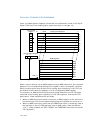
Vol. 3 11-51
MEMORY CACHE CONTROL
The values in all the entries of the PAT can be changed by writing to the IA32_PAT
MSR using the WRMSR instruction. The IA32_PAT MSR is read and write accessible
(use of the RDMSR and WRMSR instructions, respectively) to software operating at a
CPL of 0.
Table 11-10 shows the allowable encoding of the entries in the PAT.
Attempting to write an undefined memory type encoding into the PAT causes a
general-protection (#GP) exception to be generated.
The operating system is responsible for insuring that changes to a PAT entry occur in
a manner that maintains the consistency of the processor caches and translation
lookaside buffers (TLB). This is accomplished by following the procedure as specified
in
Section 11.11.8, “MTRR Considerations in MP Systems,” for changing the value of
an MTRR in a multiple processor system. It requires a specific sequence of operations
that includes flushing the processors caches and TLBs.
The PAT allows any memory type to be specified in the page tables, and therefore it
is possible to have a single physical page mapped to two or more different linear
addresses, each with different memory types. Intel does not support this practice
because it may lead to undefined operations that can result in a system failure. In
particular, a WC page must never be aliased to a cacheable page because WC writes
may not check the processor caches.
When remapping a page that was previously mapped as a cacheable memory type to
a WC page, an operating system can avoid this type of aliasing by doing the
following:
1. Remove the previous mapping to a cacheable memory type in the page tables;
that is, make them not present.
2. Flush the TLBs of processors that may have used the mapping, even specula-
tively.
3. Create a new mapping to the same physical address with a new memory type, for
instance, WC.
4. Flush the caches on all processors that may have used the mapping previously.
Note on processors that support self-snooping, CPUID feature flag bit 27, this
step is unnecessary.
Operating systems that use a page directory as a page table (to map large pages)
and enable page size extensions must carefully scrutinize the use of the PAT index bit
for the 4-KByte page-table entries. The PAT index bit for a page-table entry (bit 7)
corresponds to the page size bit in a page-directory entry. Therefore, the operating
system can only use PAT entries PA0 through PA3 when setting the caching type for
a page table that is also used as a page directory. If the operating system attempts
to use PAT entries PA4 through PA7 when using this memory as a page table, it effec
-
tively sets the PS bit for the access to this memory as a page directory.
For compatibility with earlier IA-32 processors that do not support the PAT, care
should be taken in selecting the encodings for entries in the PAT (see Section
11.12.5, “PAT Compatibility with Earlier IA-32 Processors”).


















